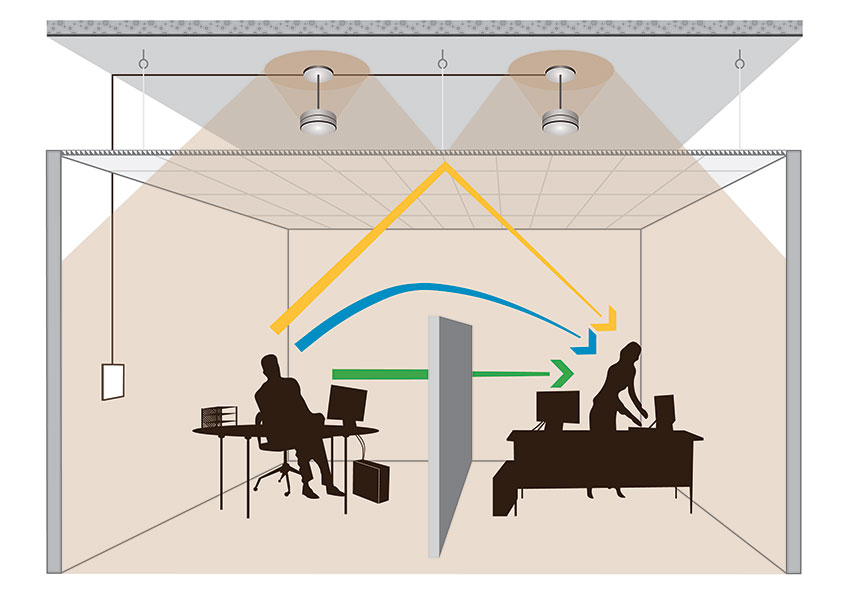Rethinking Acoustics
Learning Objectives:
- Establish a common language when discussing acoustical issues.
- Explain the role minimum background sounds plays in human perception of acoustics.
- Capitalize on the ways in which sound masking can be used as an architectural design tool.
- Address concerns regarding sound masking and the Lombard effect.
Credits:
This course is approved as a Structured Course
This course can be self-reported to the AANB, as per their CE Guidelines
Approved for structured learning
Approved for Core Learning
This course can be self-reported to the NLAA
Course may qualify for Learning Hours with NWTAA
Course eligible for OAA Learning Hours
This course is approved as a core course
This course can be self-reported for Learning Units to the Architectural Institute of British Columbia
Acoustics is a vital part of our everyday experience of the built environment; however, the role background sound plays in making these environments more comfortable for occupants is often overlooked. As a result, the misconception persists that acoustical dissatisfaction and lack of speech privacy can be resolved merely by limiting noise levels or blocking transmission.
Given today’s focus on health and wellness, it seems prudent to revisit our acoustical lexicon with the intention of developing deeper awareness of the differences between background sound and noise as well as their implications for our experience within facilities.
Refining our understanding of “noise” and “sound,” as well as terms such as “silence” and “quiet,” allows for a more nuanced discussion of occupants’ needs and expectations, and fosters opportunities to improve building design practices.
Indeed, it is only by controlling background sound—in contrast to limiting background noise—that one can realize certain benefits, such as increased speech privacy and improved specification of construction requirements, as well as the associated labor and cost savings.
Architectural Acoustics
The study of acoustics dates back thousands of years. Given its roots are deeply entangled with those of mathematics and physics, it is unsurprising the typical approach to acoustic investigation is quantitative. Consideration of “soft” parameters (i.e., subjective and descriptive) is relatively scarce until the last century.
Interest in evaluating human response to acoustics gained momentum in the 1900s with the rise of architectural acoustics—also known as building or room acoustics. Most notably, contributions from Bell Telephone Laboratories, Bolt Beranek & Newman Inc., and others formed the foundation for psychoacoustics, a branch of psychology focusing on the perception of sound and its physiological effects. Research examined occupants’ assessment of intruding noise (e.g., annoyance, distraction, inadequate acoustical privacy) in their environment.
Motivated by the need to develop an objective approach to effective architectural acoustical design, William Cavanaugh et al. published Speech Privacy in Buildings (1962), asserting neither acoustical privacy nor acoustical satisfaction could be guaranteed by any single design parameter. This work was instrumental in what became to be understood as the ABCs: of architectural acoustical design:
- “A” is for “absorb,” which involves providing sufficient, but not excessive, absorptive materials, in order to reduce the amount of sound energy within the space;
- “B” is for “block,” which involves providing sufficient isolation within the space; and
- “C” is for “cover”—or one might say “control”—which involves management of the spectral distribution and overall level of background sound within the space with the intention of masking speech and noise (rather than, for example, adding biophilic sounds with the intention of increasing occupant connectivity with the natural environment).
Although the authors of Speech Privacy in Buildings appreciated the importance of background sound, they tended to use the words “noise” and “sound” interchangeably—a practice deeply rooted in historical habits, which continues today.

Photo courtesy of KR Moeller Associates Ltd.
The ABCs of architectural acoustical design involve using a variety of methods and materials to absorb, block and cover noise with the intention of creating an environment that is more comfortable for occupants and supportive of their tasks.

Photo courtesy of iStockPhoto/Emir Memedovski
An individual’s assessment of sound depends on a variety of factors, such as their expectations for the environment, the task in which they are engaged, the sound’s level and frequency content, as well as the level and spectral distribution of background sound present within the space.
The signal-to-noise ratio
Initially, acousticians such as those at Bell Telephone Laboratories were primarily interested in evaluating the conditions needed to clearly hear sounds. They determined the critical factor was the level of the desired sound—called the “signal”—relative to that of the background sound present in the listener’s location. In most cases, the background sound used during testing was broadband and did not contain information (i.e., noticeable patterns, such as running speech, nature sounds, traffic noise); however, it was termed “noise” because it could potentially interfere with the intelligibility of the desired sound. The ratio of the desired sound to background sound was termed the signal-to-noise ratio.
In the above case the “signal” is the sound one wants to hear because it conveys useful information, while the “noise” is an unwanted input challenging one’s ability to clearly hear the desired sound. As acousticians developed an understanding of background sound as a fundamental component of speech privacy, the methodology—and the terminology—remained the same. Hence, the word “noise” continued to be used to describe the background—or, in this case, the masking—sound, despite the fact it was now being viewed in a positive light.
Understandably, the term “noise” can cause confusion when the “signal” is the unwanted sound and the “noise” is actually the desired background sound. Meanwhile, the general public tends to use “noise” as a non-technical descriptive word, typically when relating negative acoustical experiences—ones that are uncomfortable, annoying, disturbing, or even painful.
To highlight the difference in the way in which “noise” is used, consider an individual working in an office, who complains about “noise” to a colleague. There are several sources of sound within the space (exterior traffic, a fan, and a radio playing music), but the source bothering the individual is a heated debate taking place in the meeting room adjacent to a workspace. In this scenario, the terms are defined in this way:
- Sound – there are four sound sources identified in the workplace.
- Signal – the noise capturing the individual’s attention (i.e., the debate) and, hence, the cause of their complaint.
- Noise – the individual uses the word “noise” to describe the debate. However, if the term is used in a technical assessment of this environment, the “noise” is actually the combination of all other sound sources (i.e., the traffic, fan, and radio), excluding the signal (i.e., the debate).
Technical use of the word “noise” requires a “signal.” In this case, noise accounts for the combination of sounds (i.e., it considers everything that is not the signal), while the signal only considers the source of the sound that is of interest.
The Human Factor
What turns a “sound” into a “noise” in the common vernacular? Humans demonstrate remarkable tolerance to sound and are only susceptible to its disruptions when they become aware of it—typically when the level of sound is too high, its qualities are unbalanced (e.g., it is too “hissy” or “rumbly”), or it presents with temporal instability of its dynamic range (i.e., the change and/or rate of change in sound level over time).
















